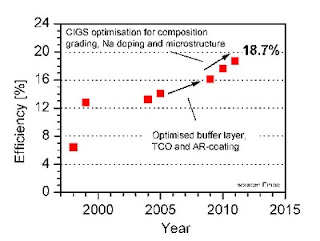The technology yielding flexible solar cells with an 18.7% world record efficiency developed by scientists at Empa, the Swiss Federal Laboratories for Materials Science and Technology, has now been published in “Nature Materials”. Key to the breakthrough is the control of the energy band gap grading in the copper indium gallium (di)selenide semiconductor, also known as CIGS, the layer that absorbs light and converts it into electricity.
High-performance flexible and lightweight solar cells, say, on plastic foils, have excellent potential to lower the manufacturing costs through roll-to-roll processing and the so called “balance-of-system” cost, thus enabling affordable solar electricity in the near future. Thus far, however, flexible solar cells on polymer films have been lacking behind in performance compared to rigid cells, primarily because polymer films require much lower temperatures during deposition of the absorber layer, generally resulting in much lower efficiencies.
Record-breaking team
The research team at Empa's Laboratory for Thin Film and Photovoltaics, led by Ayodhya N. Tiwari, has been involved in the development of high-efficiency CIGS solar cells on both glass and flexible substrates with a special focus on reducing the deposition temperature of the CIGS layer. The group has repeatedly increased efficiency of flexible CIGS solar cells over the past years – first at ETH Zurich and now since three years at Empa. With their current record value of 18.7% Tiwari and his team nearly closed the efficiency gap to cells based on multi-crystalline silicon (Si) wafers or CIGS cells on glass. The scientific details of their novel low-temperature deposition technology and the multi-layered device have recently been published in “Nature Materials”.
Both efficiencies were independently certified by the Fraunhofer Institute for Solar Energy Systems (ISE) in Freiburg, Germany. “We have thus shown that this low-temperature process is also applicable on low-cost metal foils such as aluminum or Mild-steel, achieving comparably high-efficiency cells and indicating a severe cost reduction potential with this technology”, said Tiwari.
Scientists at FLISOM, a start-up company, and Empa have been collaborating to further develop low-temperature processing, and FLISOM is scaling up the technology for roll-to-roll manufacturing of monolithically interconnected solar modules and commercializing the technology. The research has been supported by the Swiss National Science Foundation (SNSF), the Commission for Technology and Innovation (CTI), the Swiss Federal Office of Energy (SFOE), EU Framework Programmes as well as by Swiss companies W. Blösch AG and FLISOM.
Further Information: Prof. Dr. Ayodhya N. Tiwari, Thin Film and Photovoltaics, Tel. +41 58 765 41 30 ayodhya.tiwari@empa.ch
Editor / Media contact, Dr. Michael Hagmann, Communication Dept. Tel. +41 58 765 45 92 redaktion@empa.ch













No comments:
Post a Comment